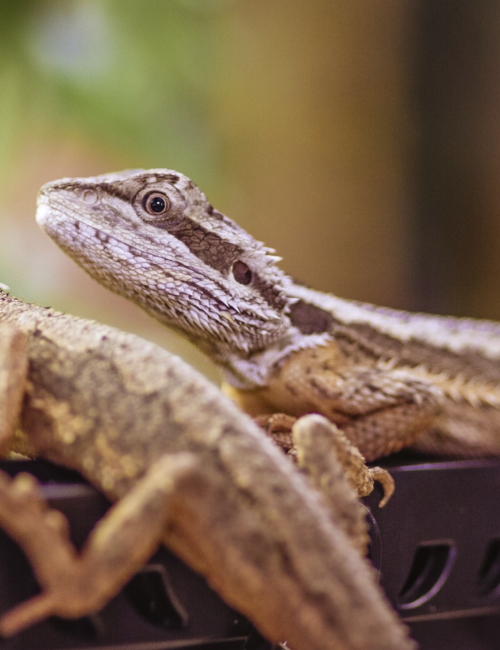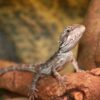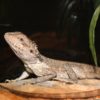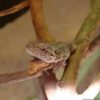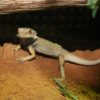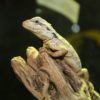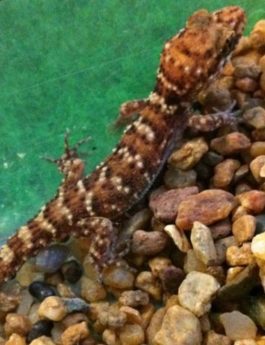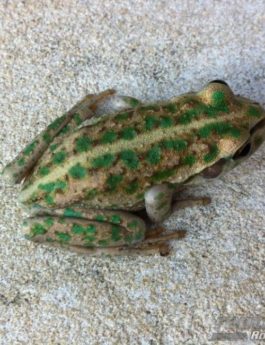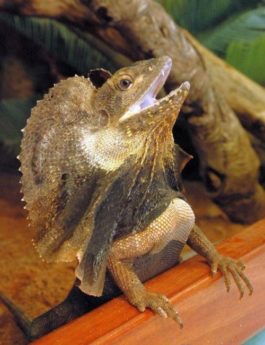Moderate to very large species with relatively short limbs and weakly to strongly dorsally depressed bodies. Typanum exposed. Many spines over body, limbs and tail, including a row across base of head, a row at rear edge of the lower jaw extending across throat to form a ‘beard’ in most species and prominent long spines along flanks. Pogona minor minor: SVL 115mm – 163mm Is moderately slender and narrow headed with a longitudinal row of spines along each side of nape (back of neck). Interior of mouth yellow in south and pinkish white in the north. Grey to greyish brown with two rows of pale blotches between the nape and hips, occasionally coalescing to form wavy broken stripes and sometimes joined by weak narrow transverse lines.
Terrestrial and arboreal, favouring elevated perches such as low vegetation, stumps, fence posts or rocks. Hollow limbs and shallow depressions beneath vegetation or surface debris are used for shelter. Extends through a variety of dry sclerophyll forests, woodlands, coastal dunes and heathlands from southern WA (excluding humid lower south-west) north to Pilbara region, east to south-western NT and Eyre Peninsula, SA.
Terrarium: there are several terrariums of different sizes available, the required size will vary based on number of and age/size of the bearded dragons. Terrariums should be large enough to maintain a correct thermal gradient in ambient air temperatures, this means that the dragon can regulate its body temperature throughout the enclosure. For a single average size mature bearded dragon, we wouldn’t recommend anything smaller than 60x45x60cm (WxDxH), and for a pair of adult dragons we would recommend a terrarium size of 90x45x60cm (WxDxH) as there needs to be enough room for them to chase their food and have their own basking spots.
Lighting & heating: Western Bearded Dragons are a ‘Day Active’ lizard, meaning they are Diurnal and therefore require high spectrum UVB lighting as well as an intense basking heat source. There are a number of ways to provide UVB, fluorescent 10.0 spectrum tubes or bulbs will provide UVB, a ‘daylight basking’ heat globe will have to be used in conjunction. A mercury vapour globe will provide intense UVA & UVB light, mercury vapour globes are in our opinion superior to fluorescents as it is a longer lasting globe with more intense UVB output, however they cannot be used with a thermostat so work better with a larger enclosure that will easier maintain a thermal gradient. During the day, you want to achieve a basking ‘Hot Spot’ of 38°C and an air temperature ranging from 35°C in the hot end, and down to 20-25°C in the cool end. A heat rock or heat tile should be provided as tummy heat to help with digestion, this can also be used as a night time heat source. To monitor the temperatures inside the enclosure a thermometer should always be used.
Furnishings: an elevated basking area can be provided using logs, vines or hammocks. Artificial foliage throughout the enclosure will allow the bearded dragon plenty of hiding spots and coverage, a water bowl placed in the cool end, a red sand kept at the correct moister is our recommended substrate.
Food in captivity: Western Bearded Dragons will eat mostly crickets, wood roaches and silk worms in captivity as they are primarily insectivores. Some will take to eating an appropriate variety of fruits and vegetables as well as insects. Food items will need to be dusted with calcium and vitamin supplements.
The essentials:
- Terrarium of appropriate size
- High spectrum UVB lighting
- Daytime Basking globe
- Thermometer
- Ground heat
- Water bowl
- Substrate
- Branches/Vines
- Foliage for shelter
- Calcium and vitamin supplements

